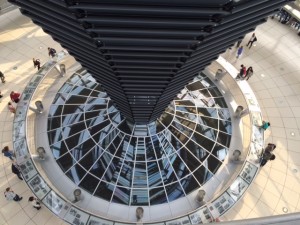Berlin was a totally new city for me, with an unfamiliar layout and a totally foreign language. Nothing drives home what you read in books by being there. Last year, the maxims about the extremely mountainous landscape of Greece were driven home. This year, the lesson to see was that Berlin had been destroyed by the war. Completely different from London, Paris, or even Bayeux, there were very few older buildings. What older ones there were often showed visible exterior signs of wartime damage: pockmarked surfaces and stones that did not match. If the Reichstag, the Pergamon Museum, and the Neues Museum are any indication, many of the old-façade buildings are only shells – the interior is strikingly modern. The Neues Museum interior was once designed as a work of art in itself, with various rooms attempting to replicate the feel of the ancient civilization whence their contents came. All that remains are sad remnants in places and audioguide recordings that can only describe lost rooms. I can imagine that this is the case in buildings across the city. I certainly can understand the sentiment that modern Berlin lacks its own architectural character, something feels off about it. Perhaps it was the weather, perhaps it was because I got sick, or maybe because I had just come from the incomparable Paris, but I did not particularly love the city of Berlin. I did enjoy its museums however.
In each of the museums visited in Berlin, what happened during the war has been dealt with in a forthright and factual manner. What is more, it is difficult to find fault with the museums for having attempted to glaze-over or sugarcoat anything. Again, Germany has the greatest guilt to carry. In spite of or perhaps because of this, they have held nothing back. For example, in the German Historical Museum, the Nazi rise to power and the war is presented more through a cultural lens rather than a political or military one. There is a potentially dangerous line between explaining and excusing. The cultural approach allows the information to remain on the ‘explain side’ of that line.
 Nazi poser in German Historical Museum
Nazi poser in German Historical Museum
The holocaust and other oppressive actions of the Nazi State are given equally honest treatment. Many of the concentration camps are preserved, such as Sachsenhausen, and open to the public. There is also a specific museum about the totalitarian government standing on the site of the old Gestapo headquarters. Within this museum, all the hardship of living under the Nazi yoke in Germany is laid bare. Again, nothing is held back. Something notable that seems to be common throughout all museums here is that when people were executed by the state (not killed in a camp but tried and executed), is that it is always said that they were murdered, stressing the total illegality of the action. Utterly different from France, I was very pleased overall with the honest approach of their World War Two Museums, although I think the suffering of their civilians and soldiers is severely under-memorialized. This dearth of grief is also totally different from Britain and France, where it often seems like there is a monument on every corner.
View of the Riechstag – Outside vs inside.

